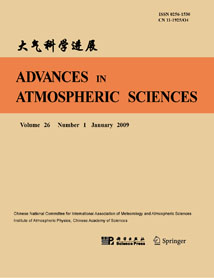| [1] |
MING Jie, NI Yunqi, SHEN Xinyong,
2009: The Dynamical Characteristics and Wave Structure of Typhoon Rananim (2004), ADVANCES IN ATMOSPHERIC SCIENCES, 26, 523-542.
doi: 10.1007/s00376-009-0523-0
|
| [2] |
Meiying DONG, Chunxiao JI, Feng CHEN, Yuqing WANG,
2019: Numerical Study of Boundary Layer Structure and Rainfall after Landfall of Typhoon Fitow (2013): Sensitivity to Planetary Boundary Layer Parameterization, ADVANCES IN ATMOSPHERIC SCIENCES, 36, 431-450.
doi: 10.1007/s00376-018-7281-9
|
| [3] |
Zhao Ming, Xu Yinzi, Wu Rongsheng,
1989: The Wind Structure in Planetary Boundary Layer, ADVANCES IN ATMOSPHERIC SCIENCES, 6, 365-376.
doi: 10.1007/BF02661542
|
| [4] |
Zhu Cuijuan, Li Xingsheng, Ye Zhuojia,
1984: AN ANALYSIS OF THE STRUCTURE OF THUNDERSTORM IN THE ATMOSPHERIC BOUNDARY LAYER, ADVANCES IN ATMOSPHERIC SCIENCES, 1, 105-118.
doi: 10.1007/BF03187621
|
| [5] |
Tan Zhemin, Wang Yuan,
2002: Wind Structure in an Intermediate Boundary Layer Model Based on Ekman Momentum Approximation, ADVANCES IN ATMOSPHERIC SCIENCES, 19, 266-278.
doi: 10.1007/s00376-002-0021-0
|
| [6] |
TANG Xiaodong, TAN Zhemin,
2006: Boundary-Layer Wind Structure in a Landfalling Tropical Cyclone, ADVANCES IN ATMOSPHERIC SCIENCES, 23, 737-749.
doi: 10.1007/s00376-006-0737-3
|
| [7] |
LIU Hongnian, JIANG Weimei, HUANG Jian, MAO Weikang,
2011: Characteristics of the Boundary Layer Structure of Sea Fog on the Coast of Southern China, ADVANCES IN ATMOSPHERIC SCIENCES, 28, 1377-1389.
doi: 10.1007/s00376-011-0191-8
|
| [8] |
WEI Na, LI Ying,
2013: A Modeling Study of Land Surface Process Impacts on Inland Behavior of Typhoon Rananim (2004), ADVANCES IN ATMOSPHERIC SCIENCES, 30, 367-381.
doi: 10.1007/s00376-012-1242-5
|
| [9] |
ZHANG Guangzhi, XU Xiangde, WANG Jizhi,
2003: A Dynamic Study of Ekman Characteristics by Using 1998 SCSMEX and TIPEX Boundary Layer Data, ADVANCES IN ATMOSPHERIC SCIENCES, 20, 349-356.
doi: 10.1007/BF02690793
|
| [10] |
ZHOU Li, XU Xiangde, DING Guoan, ZHOU Mingyu, CHENG Xinghong,
2005: Diurnal Variations of Air Pollution and Atmospheric Boundary Layer Structure in Beijing During Winter 2000/2001, ADVANCES IN ATMOSPHERIC SCIENCES, 22, 126-132.
doi: 10.1007/BF02930876
|
| [11] |
Keon-Tae SOHN, H. Joe KWON, Ae-Sook SUH,
2003: Prediction of Typhoon Tracks Using Dynamic Linear Models, ADVANCES IN ATMOSPHERIC SCIENCES, 20, 379-384.
doi: 10.1007/BF02690796
|
| [12] |
Zhe-Min TAN, Lili LEI, Yuqing WANG, Yinglong XU, Yi ZHANG,
2022: Typhoon Track, Intensity, and Structure: From Theory to Prediction, ADVANCES IN ATMOSPHERIC SCIENCES, 39, 1789-1799.
doi: 10.1007/s00376-022-2212-1
|
| [13] |
Xuelong CHEN, Yajing LIU, Yaoming MA, Weiqiang MA, Xiangde XU, Xinghong CHENG, Luhan LI, Xin XU, Binbin WANG,
2024: TP-PROFILE: Monitoring the Thermodynamic Structure of the Troposphere over the Third Pole, ADVANCES IN ATMOSPHERIC SCIENCES.
doi: 10.1007/s00376-023-3199-y
|
| [14] |
P.C. Chu, Roland W. Garwood, Jr.,
1990: Thermodynamic Feedback between Clouds and the Ocean Surface Mixed Layer, ADVANCES IN ATMOSPHERIC SCIENCES, 7, 1-10.
doi: 10.1007/BF02919163
|
| [15] |
Li Xingsheng, Yang Shuowen,
1986: A MODEL STUDY OF THE NOCTURNAL BOUNDARY LAYER, ADVANCES IN ATMOSPHERIC SCIENCES, 3, 59-71.
doi: 10.1007/BF02680045
|
| [16] |
Lin Naishi, Zhou Zugang, Zhou Liufei,
1998: An Analytical Study on the Urban Boundary Layer, ADVANCES IN ATMOSPHERIC SCIENCES, 15, 258-266.
doi: 10.1007/s00376-998-0044-2
|
| [17] |
HAO Zhixin, ZHENG Jingyun, GE Quansheng,
2009: Variations in the Summer Monsoon Rainbands Across, ADVANCES IN ATMOSPHERIC SCIENCES, 26, 614-620.
doi: 10.1007/s00376-009-8011-0
|
| [18] |
Jinqiang ZHANG, Hongbin CHEN, Xiang'ao XIA, Wei-Chyung WANG,
2016: Dynamic and Thermodynamic Features of Low and Middle Clouds Derived from Atmospheric Radiation Measurement Program Mobile Facility Radiosonde Data at Shouxian, China, ADVANCES IN ATMOSPHERIC SCIENCES, 33, 21-33.
doi: 10.1007/s00376-015-5032-8
|
| [19] |
LING Jian, LI Chongyin, ZHOU Wen, JIA Xiaolong, Chidong ZHANG,
2013: Effect of Boundary Layer Latent Heating on MJO Simulations, ADVANCES IN ATMOSPHERIC SCIENCES, 30, 101-115.
doi: 10.1007/s00376-012-2031-x
|
| [20] |
MIAO Shiguang, JIANG Weimei,
2004: Large Eddy Simulation and Study of the Urban Boundary Layer, ADVANCES IN ATMOSPHERIC SCIENCES, 21, 650-661.
doi: 10.1007/BF02915732
|















 AAS Website
AAS Website 
 AAS WeChat
AAS WeChat 
 DownLoad:
DownLoad: